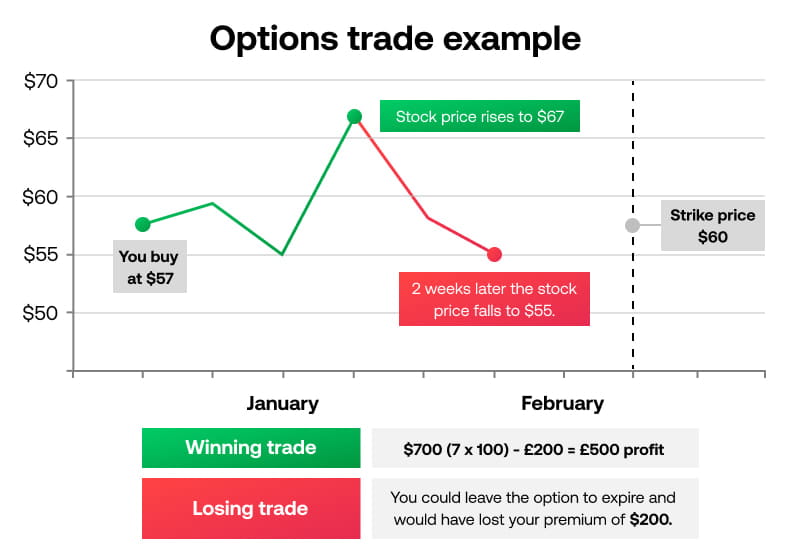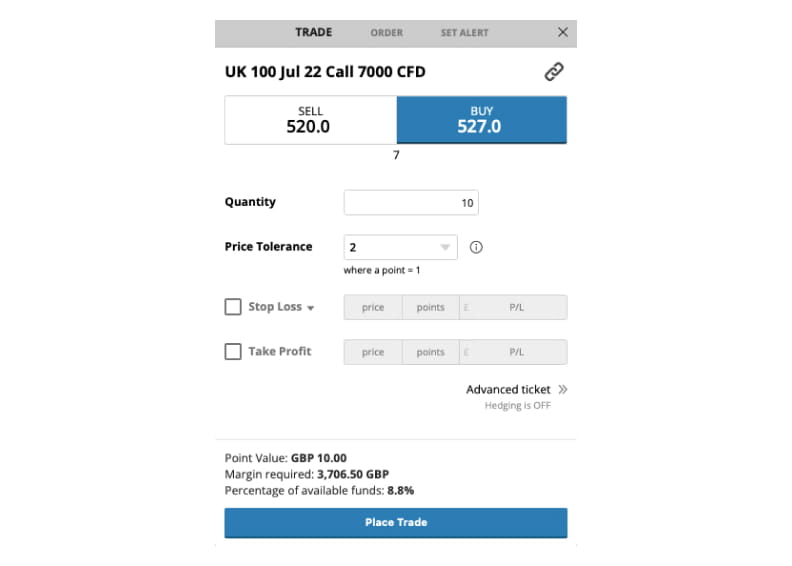
Trading with leverage
Options trading explained
Like futures, options trading allow you to buy or sell an asset at a set price in the future. However, there are a few key differences to be aware of. Let’s go through them.
- What are options?
- How do options work?
- Example of an options trade
- Why trade options?
- How to trade options
What are options?
Options are a financial derivative instrument that give you the right, but not the obligation, to purchase or sell an asset at a specified price (known as the strike price) before a certain expiry date.
They differ from futures because there is no obligation on behalf of a trader to take delivery of an asset when the option expires. However, like futures, options have a limited shelf life – a date at which they expire.
Another key difference is that when you buy an options contract it comes with a premium – this is the price of owning the option.
Think of an options seller as the insurance company – they’re getting a fixed cost from you but will potentially have to pay a huge sum if you need them to.
For example, you might pay a premium of £10 for an option, and end up with a £50 profit. This would mean the option’s seller initially gained £10 but eventually lost £50.
Like futures, options are normally traded in a standardised format on options exchanges. The largest options exchange in the world is the Chicago Board Options Exchange (CBOE). You can also trade options OTC.
How do options work?
Options work in different ways depending on whether you’re buying or selling the option. There are two types of options contracts – calls and puts – which are used to speculate on the direction of an asset, and you can buy or sell either.
Confused? Not to worry, we’ll go through each position you can take now.
Call option
A call options gives you the right to buy an asset at a set price.
Buyers of a call option are speculating on an increase in the price of the asset. They have the right to buy the asset at the strike price of the contract. If the market falls instead, they can leave their contract to expire worthless and lose only the premium they paid.
Sellers of a call option are expecting there to be no movement or a decrease in the price of the asset. If the market does move higher, their loss is potentially unlimited. They are hoping to receive the fixed premium without having to sell their holding.
Put option
This gives you the right to sell an asset at a future price.
Buyers of a put option are speculating on a decline in the price of the asset. They have the right to sell the asset at the strike price of the contract. If the market price rises instead, they can let the contract expire.
Sellers of a put option would be agreeing to receive a premium in exchange for the obligation to sell an asset at a potentially unlimited cost. They’d be hoping to take the premium without having to buy the asset.
For buyers, the premium paid is the maximum potential loss. But that’s not to say there are no other risks involved. Prices can change quickly which means options traders may lose their capital in a relatively short period of time. A risk management strategy is crucial for any trader. Learn more in our guide to strategies and risk.
Example of an options trade
On January 1st, the stock price of company ABC is $57 and the premium is $2 for a February 60 Call. This indicates that the expiration of the contract is the third Friday of February and the strike price is $60.
When you buy an option, it represents 100 shares, so the total price of the options contract is $2 x 100 = $200.

Profitable option
If the stock price rose to $67 in 3 weeks, the options contract will have increased and you would be able to sell your option for a profit since it’s trading above the strike price.
The market has moved $10 in your favour, settling your position $7 above the strike price. So you’d have made $700 (7x100) minus the $200 premium, resulting in a $500 profit.
Losing option
If the stock price declined to $55 in the next couple of weeks, you would choose not to exercise the option because you could buy the stock for $5 cheaper per share on the stock market.
You could leave the option to expire and would have lost your premium of $200
Why trade options?
Options are frequently used by investors to help them manage the risk in their portfolios by hedging. For example, an investor with a portfolio of UK shares might buy a put option on the UK 100. The value of this option will go up in value as the UK 100 falls.
There are many different types of trading strategies that traders use to profit and hedge their risk. You can find out in our trading strategies course, here.
Options give traders the choice of whether to exercise them. The premium paid for an option can be more cost efficient than a futures contract too.
How to trade options
At City Index, we offer a number of options markets using financial spread betting and CFDs.

You can see our range of options markets here.

